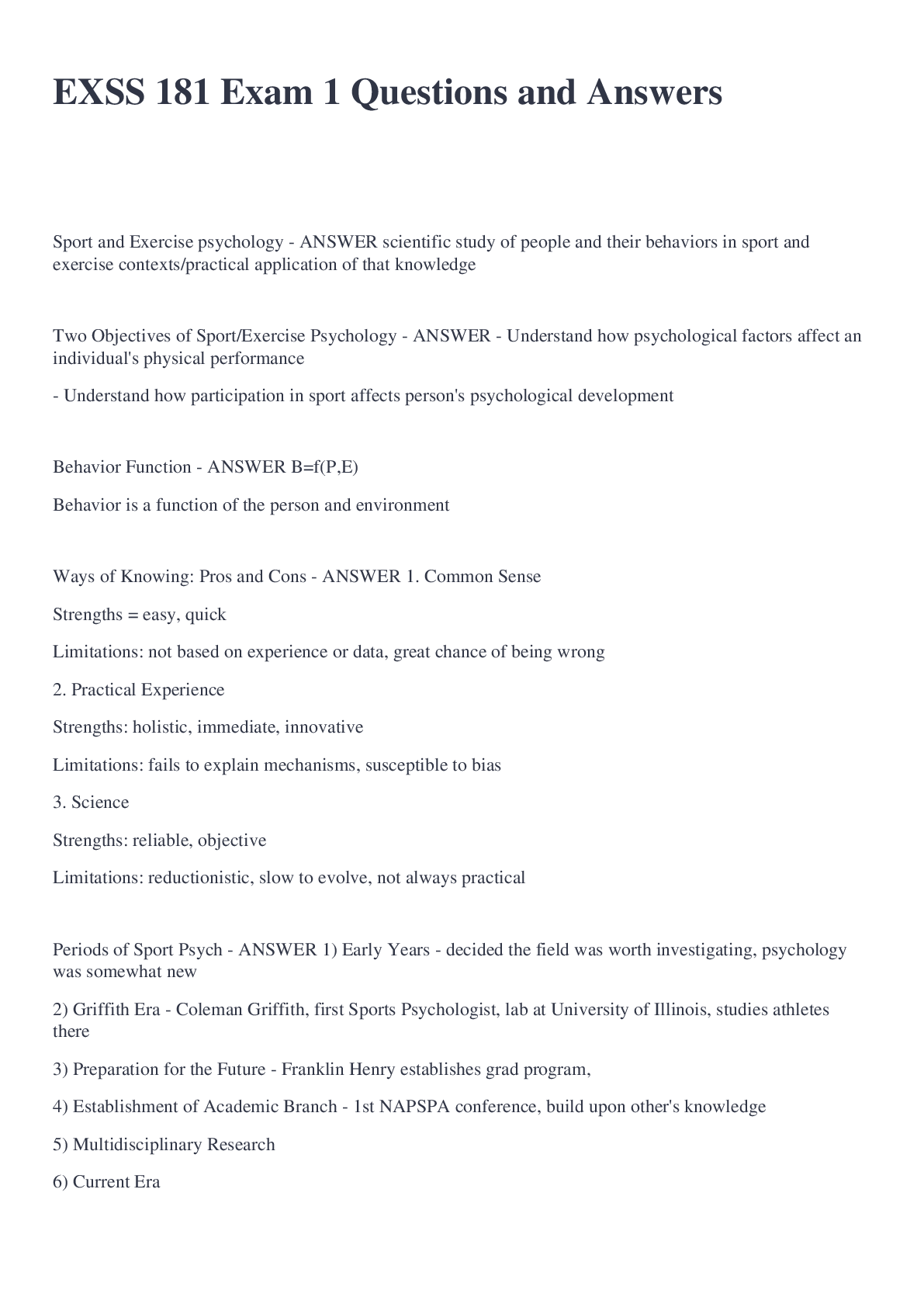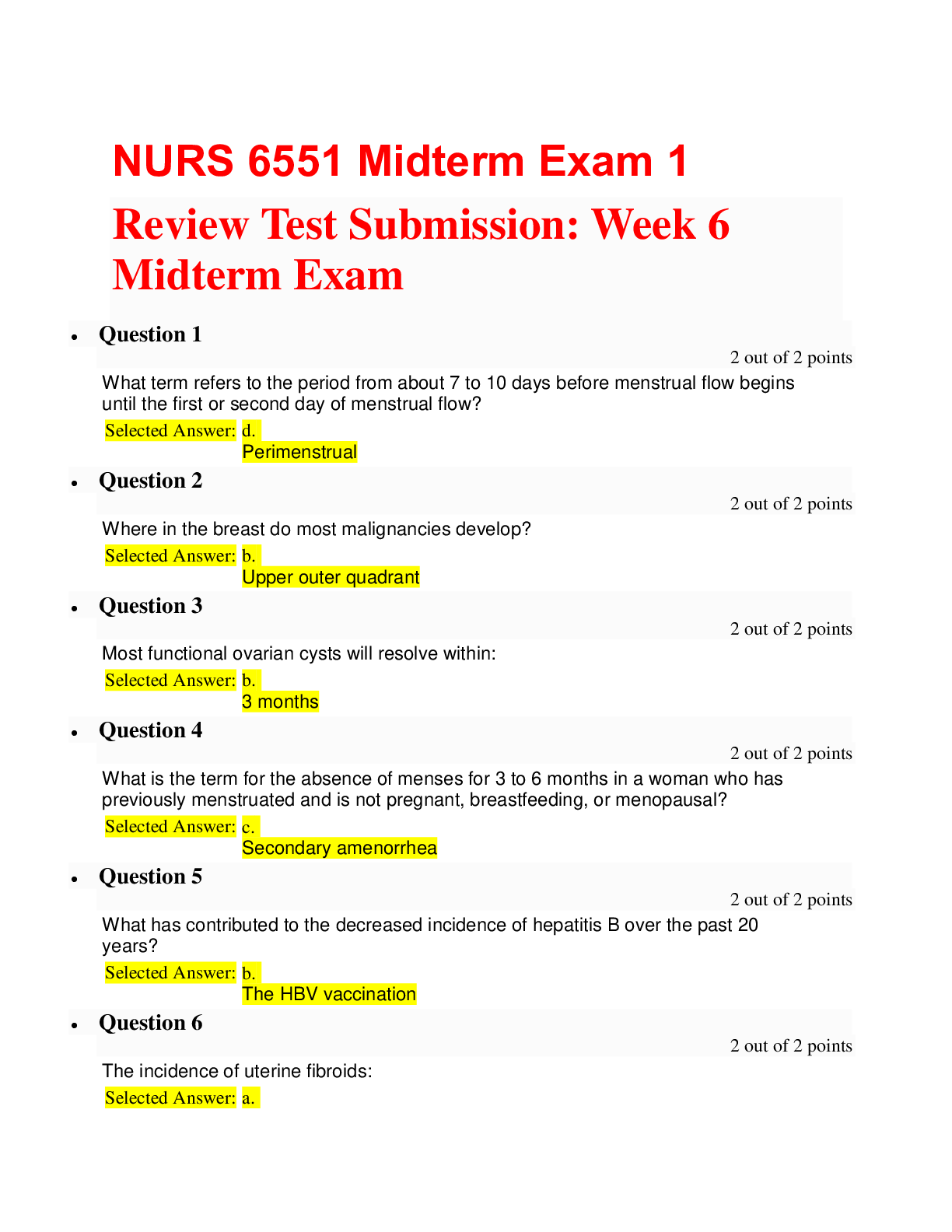EXSS 181 Exam 1 Questions and Answers
Document Content and Description Below
Sport and Exercise psychology - ANSWER scientific study of people and their behaviors in sport and exercise contexts/practical application of that knowledge Two Objectives of Sport/Exercise Psychol... ogy - ANSWER - Understand how psychological factors affect an individual's physical performance - Understand how participation in sport affects person's psychological development Behavior Function - ANSWER B=f(P,E) Behavior is a function of the person and environment Ways of Knowing: Pros and Cons - ANSWER 1. Common Sense Strengths = easy, quick Limitations: not based on experience or data, great chance of being wrong 2. Practical Experience Strengths: holistic, immediate, innovative Limitations: fails to explain mechanisms, susceptible to bias 3. Science Strengths: reliable, objective Limitations: reductionistic, slow to evolve, not always practical Periods of Sport Psych - ANSWER 1) Early Years - decided the field was worth investigating, psychology was somewhat new 2) Griffith Era - Coleman Griffith, first Sports Psychologist, lab at University of Illinois, studies athletes there 3) Preparation for the Future - Franklin Henry establishes grad program, 4) Establishment of Academic Branch - 1st NAPSPA conference, build upon other's knowledge 5) Multidisciplinary Research 6) Current Era Norman Triplett - ANSWER studied social facilitation of bikers, whether they rode faster with others around Coleman Griffith - ANSWER father of modern sport psych, made 1st research lab ABC's of sport psych - ANSWER A - affect (how we feel) B- behavior (effort/motivation/performance) C- cognition (why do people choke, self-referential thoughts) Affect vs. Emotion vs. Mood - ANSWER Affect: how we feel generally, positive vs. negative Emotion: combination of affect and behavior, directed at particular stimulus Mood: how we express emotion/affect Hollander's Model of Personality - ANSWER Psychological core: most basic/deepest level (attitudes, values, interests, beliefs), most stable Typical Responses: how we respond to environment Role-related behavior: how we act based on perceptions/situation, may conflict behaviorally Psychodynamic Approach - ANSWER freud, emphasis on unconscious determinants, id ego and superego, understand as a whole rather than isolated traits, not commonly used anymore Trait Approach - ANSWER traits are consistent (behavior similar from one situation to next) and generalizable (behave similarly across contexts). CON: weak predictor of behavior, people don't always act the same way Situation Approach - ANSWER behavior determined by situation or environment, learn behavior via rewards and punishments. CON: doesn't consider traits, simplistic Social Learning Theory - ANSWER people learn behaviors for certain situations via observational learning/modeling Interactional Approach - ANSWER situation and traits together lead to behavior (B=f(P,E)), Phenomenological Approach - ANSWER similar to interactional approach however considers person's understanding and subjective interpretations of oneself and environment motivation - ANSWER direction (seeking out situations) and intensity (how much) of effort Interactional View - ANSWER how traits and situations work together to form motivational behaviors achievement motivation - ANSWER orientation to strive for success, persist in face of failure, and take pride in achieving excellence Need Achievement Theory - ANSWER interactional view that consists of personality and situational factors (probability of success vs. incentive value), resultant tendencies, emotional reactions, and achievement- related behaviors Attribution Theory - ANSWER focuses on how people explain their successes and failures Stability: attributes are permanent or unstable Causality: factor either internal or external Control: factor either under or not under control Attribution - ANSWER reason for why something happened Achievement Goal Theory - ANSWER goals, perceived ability, and achievement behavior determine motivation Underlying assumptions: 1. people are motivated to demonstrate competence 2. motivation is influenced by personal meaning to perceived success/failure Outcome goal orientation - ANSWER comparing oneself with and defeating others, great it win, bad if lose (entity view) Task Goal Orientation - ANSWER focus on improving relative past own performance (incremental focus) Competence Motivation Theory - ANSWER people are motivated to feel worthy 1. Perceptions of control work along with self-worth and competence evaluations 2. perceptions of control do not influence motivation directly 3. perceptions influence affective/emotional states -> influence motivation Learned Helplessness Theory - ANSWER perceiving actions to have no effect on desired outcome of a task or skill, felling doomed to failure, controllable and stable Self-serving bias - ANSWER making attributions that help you increase or maintain confidence For success = internal and stable For failure = external and unstable Ego/Outcome vs. Task/Mastery - ANSWER Ego/Outcome - being better than others. Task/Mastery - being better than your previous self. Independent of each other ex: Low Task Low ego = not very motivated, but not much negative affect Task Goal Involvement - ANSWER choosing learning opportunities at risk of displaying mistakes, high effort, resistance to failure Ego Goal Involvement - ANSWER avoid learning opportunities at risk of displaying error, put in just enough effort to socially compare well, give up in face of failure Undifferentiated concept of ability - ANSWER cannot differentiate between ability and effort. working hard = ability Mastery vs. Perfomance Climate - ANSWER Mastery = emphasis on learning/individual improvement, evoke task involvement. Performance = emphasis on competition, winning, evoke ego involvement TARGET - ANSWER conditions to promote mastery climate -Task -Authority -Recognition -Grouping -Evaluation -Timing autonomous competence - ANSWER children focus on mastering environments through self-testing, not looking to compare to others social comparison - ANSWER competence motivation stage 2, children focus on comparing their performance with that of others integrated state - ANSWER competence motivation stage 3, involves both social comparison and autonomous achievement strategy Self-Determination Theory Article Main Point - ANSWER social environments facilitate or forestall intrinsic motivation by supporting/thwarting innate needs *People only motivated for activities that have intrinsic interest, appeal of novelty General Self-Worth Components - ANSWER Physical, Emotional, Social, Academic Self Concepts - ANSWER 1. Multidimensional 2. hierarchical 3. influenced by others 4. information used to inform self-perceptions is developmentally influenced Stress - ANSWER relationship between person and environment, viewed as exceeding resources, dynamic (means we intervene), transactional (intervention can occur in person or environment) arousal - ANSWER blend of physiological and psychological activity in a person, intensity of motivation at a particular moment, good or bad anxiety - ANSWER negative emotional state of nervousness Thought component = cognitive anxiety Physiological component = somatic anxiety State vs. Trait Anxiety - ANSWER State = temporary, depending on situation Trait = part of personality, predisposition Primary vs. Secondary Appraisal - ANSWER Primary = what is at stake Secondary = what can be done coping - ANSWER changing cognitive/behavioral efforts used to manage demands (problem vs emotion focused) external regulation - ANSWER performing an activity to receive a reward or avoid a punishment introjected regulation - ANSWER performing a behavior to avoid guilt and anxiety Identified regulation - ANSWER performing behavior to achieve some valued, extrinsic outcome Integrated regulation - ANSWER performing a behavior because it is part of your sense of self Intrinsic Motivation - ANSWER performing an activity for its own sake Encourage Self-Determined Motivation through... - ANSWER Autonomy, Competence, Relatedness Cognitive Evaluation Theory - ANSWER critical factor is now reward, but person's perception of reward Controlling aspect: affects autonomy perceptions Information aspect: affects competence perceptions Drive Theory - ANSWER as arousal or state anxiety increases, so does performance Social Facilitation Theory - ANSWER presence of others helps performance on learned skills and inhibits performance on unlearned skills Inverted U Hypothesis - ANSWER at low arousal levels, performance will be below par. Performance increases until optimal point, then decreases again IZOF - ANSWER Individualized Zones of Optimal Functioning, optimal state anxiety (bandwidth, not necessarily in middle, differs from one to another Catastrophe Phenomenon - ANSWER physiological arousal is related to performance in an inverted U fashion, only when athlete isn't worried Reversal Theory - ANSWER arousal affects performance based on interpretation of arousal Competition - ANSWER social process occurs when rewards are given to people on the basis of comparing performances, someone else knows criteria Cooperation - ANSWER social process through which performance is evaluated and rewarded in terms of collective achievements, does NOT ignore individual, success = player's individual improvement Zero-Sum - ANSWER rewards distributed unequally, not everyone can win feedback - ANSWER information obtained about a behavior, intrinsic (internal) vs. augmented (external), functions to inform, motivate and reinforce Reinforcement vs. Punishment - ANSWER Reinforcement - increases likelihood of a behavior Punishment - decreases the likelihood of a behavior Positive vs. Negative - ANSWER Positive = add stimulus Negative = decrease stimulus both used for reinforcement and punishment Positive Approach - ANSWER AIM: strengthen desired behavior by motivating participants to perform them, reinforce behavior FOCUS: correct performance Key Elements: praise, encouragement, and instruction Negative Approach - ANSWER AIM: Eliminate undesirable behaviors through punishment and criticism FOCUS: performance errors or negative behaviors Key Problem: fear of failure Horn Study (1985) - ANSWER Purpose: examined relationship between coach behaviors and player perceptions of competence/expectancy of success Results: more positive reinforcement -> lower perceptions of competence/expectations, more criticism -> higher competence perceptions/expectations Modeling/Observational Learning - ANSWER cognitive, affective, and behavioral changes resulting from observing others Skill/Behavior acquisition - ANSWER acquire motor coordination information, develop strategies to solve movement problems Inhibition vs. Disinhibition - ANSWER Inhibition = induce anxiety Disinhibition = gain confidence Weiss, McCullach, Smith and Berlant (1998) - ANSWER Purpose: examine effect of peer coping and mastery models on children's motor performance and psychological responses in Results: no differences between modeling groups Social Learning Theory 4 Processes - ANSWER Attention, Retention, Motor Reproduction, Motivation Interpersonal Communication - ANSWER Meaningful exchange between 2 people Intrapersonal communication - ANSWER communication with ourselves, self-talk Sandwhich Approach - ANSWER 1. Positive, sincere statement (finding something done correctly) 2. Corrective information (future-oriented instructions) 3. Positive encouraging remark (compliment) Confrontation - ANSWER face-to-face discussion in conflict, NOT always a negative thing (can lead to better understanding) Convey importance of relationship and understand other's perspective, don't say solution without dis [Show More]
Last updated: 2 years ago
Preview 1 out of 8 pages

Buy this document to get the full access instantly
Instant Download Access after purchase
Buy NowInstant download
We Accept:

Reviews( 0 )
$7.00
Can't find what you want? Try our AI powered Search
Document information
Connected school, study & course
About the document
Uploaded On
Oct 01, 2022
Number of pages
8
Written in
Additional information
This document has been written for:
Uploaded
Oct 01, 2022
Downloads
0
Views
52


























